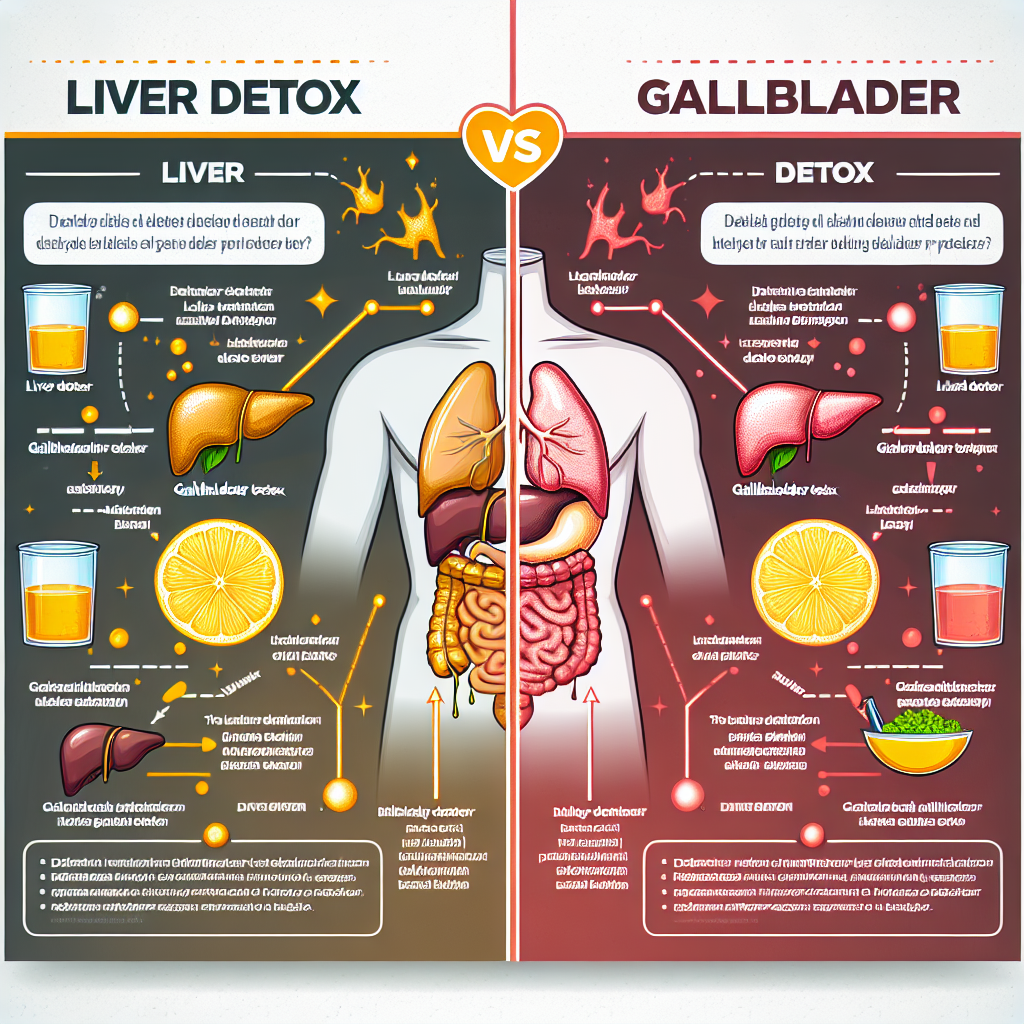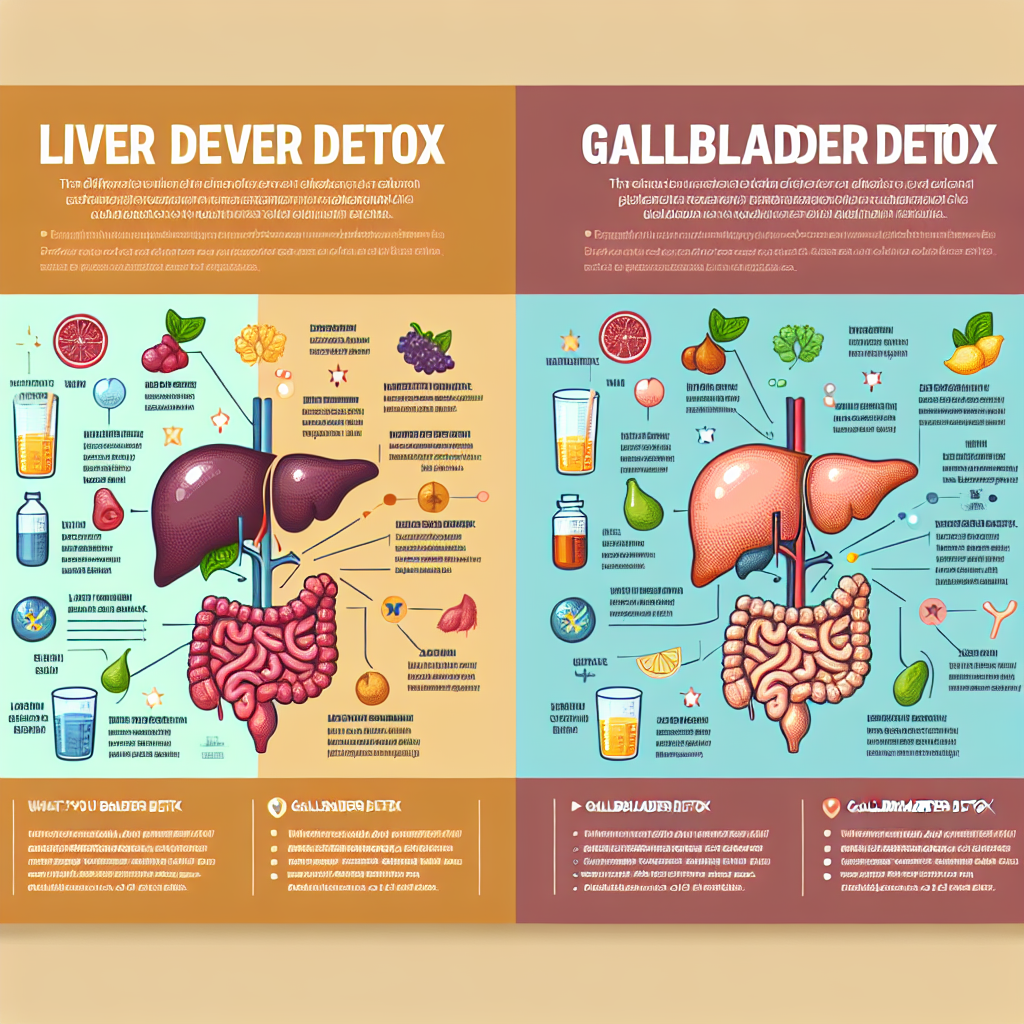Liver vs Gallbladder Detox: What’s the Difference?

Discover the difference between Liver and Gallbladder Detox on our website. Learn how each detox process works and how they can contribute to your overall health. Visit My Vibrant Vitality now to get started.
Understanding the Differences: Liver Detox vs Gallbladder Detox
The human body is a complex system that requires regular maintenance to function optimally. Among the various organs that play a crucial role in maintaining our health, the liver and gallbladder are two that often require special attention. Both organs are involved in the digestion process and the elimination of toxins from the body. However, the methods and reasons for detoxifying these organs differ significantly. Understanding the differences between a liver detox and a gallbladder detox can help you make informed decisions about your health.
The liver, one of the largest organs in the body, is essentially the body’s chemical processing plant. It performs over 500 different functions, including metabolizing fats, proteins, and carbohydrates, producing bile, and detoxifying the blood by removing harmful substances such as alcohol and drugs. Over time, the liver can become overburdened with toxins, leading to various health issues such as fatigue, weight gain, and skin problems. A liver detox aims to cleanse the liver of these toxins, thereby improving its function and overall health. This process typically involves a diet rich in fruits, vegetables, and whole grains, along with certain herbs and supplements known to support liver health.
On the other hand, the gallbladder, a small pear-shaped organ located beneath the liver, has a more specific function. It stores the bile produced by the liver and releases it into the small intestine to aid in the digestion of fats. Over time, the bile can become concentrated and form gallstones, which can cause severe abdominal pain and other complications. A gallbladder detox, also known as a gallbladder flush or cleanse, aims to eliminate these gallstones. This process typically involves consuming a large amount of olive oil and citrus juice, which is believed to stimulate the gallbladder to release the stones.
While both detoxes aim to improve the function of their respective organs, it’s important to note that their effectiveness and safety are subjects of ongoing debate. Some health professionals argue that the body is perfectly capable of detoxifying itself without the need for special diets or cleanses. They caution that these detoxes can sometimes do more harm than good, leading to nutrient deficiencies, electrolyte imbalances, and other health problems. Moreover, there’s limited scientific evidence to support the effectiveness of these detoxes. Most of the reported benefits are anecdotal, and many of the supposed “gallstones” eliminated during a gallbladder flush are actually a byproduct of the olive oil and citrus juice consumed during the cleanse.
In conclusion, while the liver and gallbladder play crucial roles in our health and may benefit from occasional detoxification, it’s essential to approach these detoxes with caution. Always consult with a healthcare professional before starting any detox regimen to ensure it’s safe and appropriate for your individual health needs. Remember, a balanced diet, regular exercise, and a healthy lifestyle are the best ways to support your liver and gallbladder health.
Liver and Gallbladder Detox: What Sets Them Apart?

The human body is a complex system that requires regular maintenance to function optimally. Among the various organs that play a crucial role in maintaining our health, the liver and gallbladder are two that often require special attention. Both organs are involved in the digestion process and the elimination of toxins from the body. However, the methods and reasons for detoxifying these organs differ significantly. This article aims to shed light on the differences between liver and gallbladder detox.
The liver, the largest internal organ in the human body, performs over 500 functions, including detoxification, protein synthesis, and the production of chemicals necessary for digestion. It is the body’s primary detoxification organ, filtering out toxins from the blood. Over time, the liver can become overburdened due to poor diet, excessive alcohol consumption, and exposure to environmental toxins. This can lead to a variety of health issues, including fatigue, weight gain, and skin problems. A liver detox, therefore, aims to support the liver in its detoxification process. This is typically achieved through a diet rich in fruits, vegetables, and whole grains, along with adequate hydration and regular exercise. Certain herbs and supplements, such as milk thistle and dandelion root, are also often recommended to support liver health.
On the other hand, the gallbladder, a small pear-shaped organ located beneath the liver, has a more specific role. It stores bile, a substance produced by the liver to aid in the digestion of fats. Over time, the bile can become concentrated and form gallstones, which can cause severe abdominal pain and other complications. A gallbladder detox, also known as a gallbladder flush or cleanse, aims to eliminate these gallstones. This is typically achieved through a diet high in fiber and low in fat, along with the consumption of certain foods and drinks, such as apple juice and olive oil, which are believed to help dissolve gallstones. However, it’s important to note that the effectiveness of gallbladder cleanses is a topic of debate among medical professionals, and they should only be undertaken under the guidance of a healthcare provider.
While both liver and gallbladder detoxes aim to improve the body’s detoxification process, they target different issues and require different approaches. A liver detox focuses on overall health and wellness, supporting the liver’s ability to filter toxins from the blood. A gallbladder detox, meanwhile, targets a specific problem – gallstones – and aims to eliminate them from the body.
In conclusion, both liver and gallbladder detoxes can play a role in maintaining optimal health. However, it’s important to remember that these detoxes are not a cure-all solution. They should be part of a broader approach to health that includes a balanced diet, regular exercise, and regular check-ups with a healthcare provider. Furthermore, before starting any detox program, it’s crucial to consult with a healthcare provider to ensure it’s safe and appropriate for your individual health needs. After all, when it comes to our health, there’s no one-size-fits-all solution.
Comparing Liver Detox and Gallbladder Detox: Key Differences Explained
The human body is a complex system that requires regular maintenance to function optimally. Among the various organs that play a crucial role in maintaining our health, the liver and gallbladder are two that often require special attention. Detoxification, a process that helps cleanse these organs, is often recommended to enhance their functionality. However, it’s important to understand the difference between a liver detox and a gallbladder detox, as each serves a unique purpose and involves different procedures.
The liver, one of the largest organs in the body, is responsible for over 500 vital functions. It processes nutrients from food, produces bile, removes toxins from the body, and helps regulate metabolism. Over time, due to factors such as poor diet, excessive alcohol consumption, and exposure to harmful substances, the liver can become overburdened and less efficient. This is where a liver detox comes in. A liver detox typically involves a diet rich in fruits, vegetables, and whole grains, along with adequate hydration. It may also include herbal supplements known for their liver-cleansing properties, such as milk thistle and dandelion root. The goal of a liver detox is to reduce the load on the liver, allowing it to function more efficiently and effectively.
On the other hand, the gallbladder, a small pear-shaped organ located beneath the liver, has a more specific function. It stores bile produced by the liver and releases it into the small intestine to aid in the digestion of fats. However, the gallbladder can develop problems such as gallstones, inflammation, and blockages, often due to a diet high in fat and cholesterol. A gallbladder detox, also known as a gallbladder flush or cleanse, aims to eliminate these issues. It typically involves fasting followed by consuming a large amount of olive oil and citrus juice. This is believed to stimulate the gallbladder to release bile and flush out any gallstones.
While both liver and gallbladder detoxes aim to improve the health and function of these organs, it’s important to note that they are not without controversy. Some medical professionals argue that the body is perfectly capable of detoxifying itself without the need for special diets or cleanses. They caution that some detox methods can be harmful, leading to dehydration, nutritional deficiencies, and even dangerous electrolyte imbalances. Therefore, it’s crucial to consult with a healthcare provider before starting any detox regimen.
In conclusion, while both liver and gallbladder detoxes aim to enhance the functionality of these organs, they differ in their methods and objectives. A liver detox focuses on improving the liver’s overall function and efficiency by reducing its workload, while a gallbladder detox aims to flush out gallstones and improve bile flow. However, the effectiveness and safety of these detox methods are still subjects of debate within the medical community. Therefore, it’s always advisable to seek professional medical advice before embarking on any detox regimen.